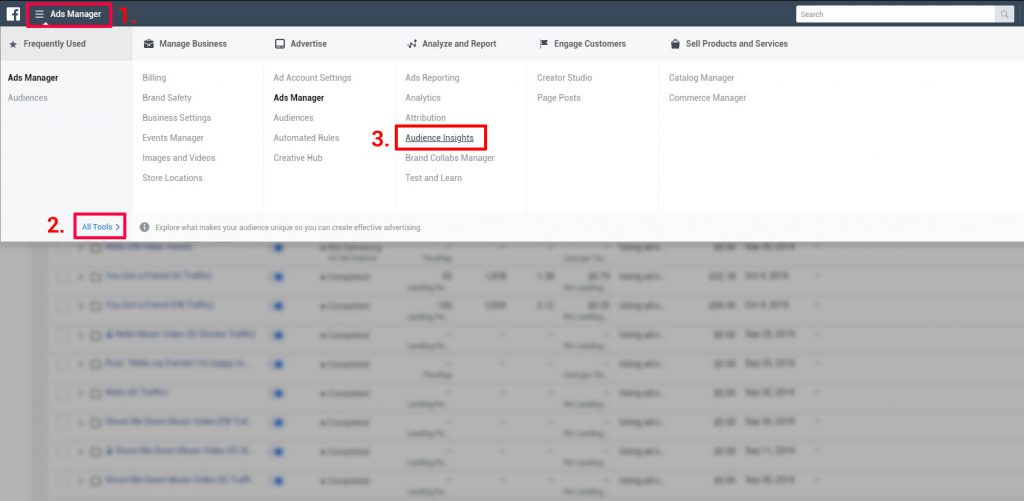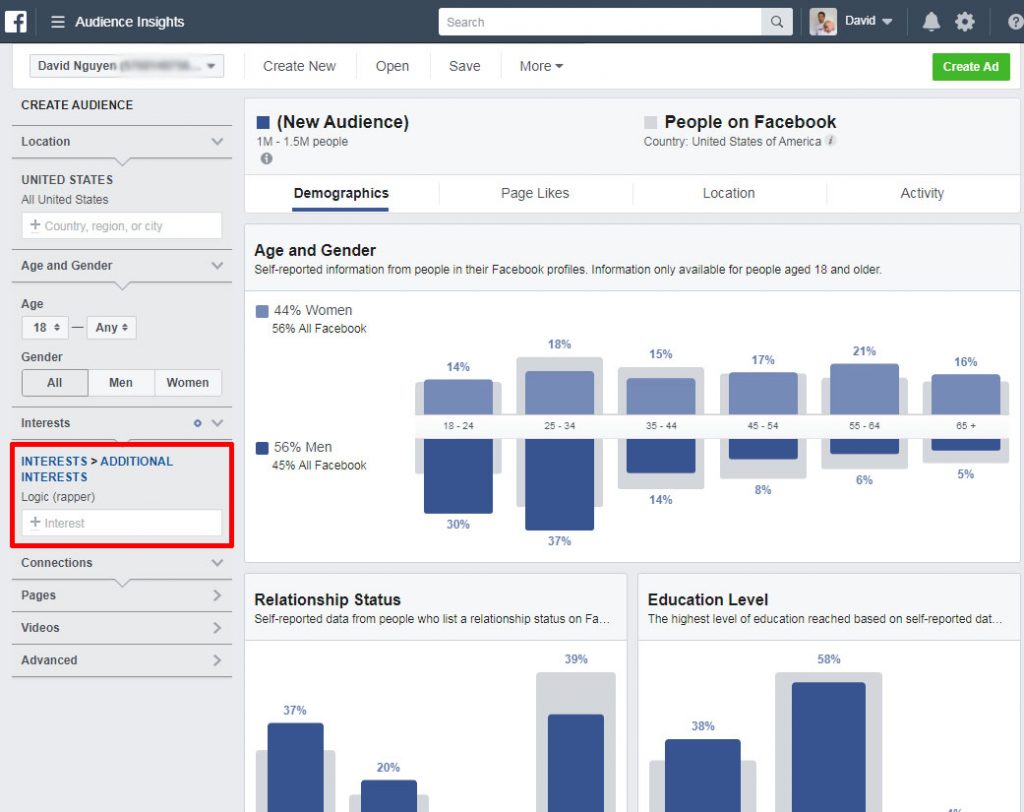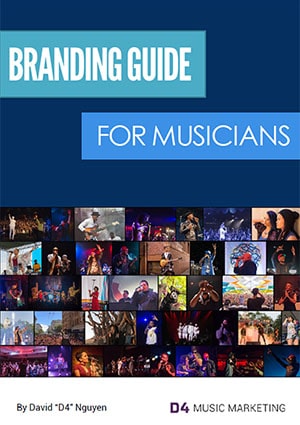
Have you struggled with getting new fans? Does it seem like no one is listening whenever you promote your music on social media? Although there can be a number of reasons for this, have you thought about who exactly your target audience is?
Just like a business needs customers, musicians need fans. To build a fanbase, one of the most fundamental steps is to identify who your target audience is. If you want to make music for a living, you have to know who to “market” or promote your music to.
How do you do all that? In this blog, I will share my perspective and approach in detail on growing a fan base by identifying your target audience first.
Why You Don’t Want to Reach a Wide Audience
One of the biggest mistakes that artists, and even musicians make when starting businesses, is having the mindset of appealing to everyone. You need to be very strategic and mindful of who you are marketing to.
You spent all this time and money to make great music, so of course, you want to have as many people as possible to hear it. But the fact is, not everyone is going to like your music or become a fan.
To save yourself time, effort and money, you need to be able to exclude and ignore certain types of people, so you can better focus on the right audience to build stronger connections with. After all, the most effective type of marketing and promotion is one where you can really get specific about who your ideal fans are.
You’re more likely to find your true ideal fans by focusing on a niche or a specific community, rather than casting a wider net of different people.
Not All Fans Are Equal
Before I go into why you want to go niche, there are two things to keep in mind about the type of fans you want.
As an emerging artist, you need fans. Not passive fans, but engaged super fans who are willing to spend money to support you.
Based on Kevin Kelly’s 1,000 fan theory, you need around 1,000 true fans in order to make a sustainable living. This doesn’t mean 1,000 social media followers. I’ll get to why in a second.
Side Note: There are shortcomings to this theory, especially because it was presented in a time (2008) where the climate of music consumption was much different than it is today. Making a profit of $100 (not revenue) from each of the 1,000 fans would not be easy with all the costs required in music production, content creation and merch. I still believe you need true fans, but how to monetize a small group of dedicated fans year after year has become more challenging for musicians.
Similarly to the 1,000 fan theory, marketing guru Seth Godin talks about how you need a “minimum viable audience” that can sustain you. In other words, you want to niche down enough that you know there are at least 1,000 true fans out there.
Secondly, the process of getting someone to become a fan and supporter of your music, which I like to call a fan funnel, is much longer now because there’s just so much noise and options. This means not everyone who follows you is a true fan or even a regular fan. It’s one thing to identify who your target audience is, but establishing a fan relationship can take more time in today’s digital world.
I know I’ve followed a lot of musicians and artists who have caught my attention based on their brand or hearing a song, but I wouldn’t consider myself a “fan” necessarily. I may stream their music and might follow them on Spotify, but I wouldn’t pay money to buy their merch or see them perform live.
Logic is a good example. I followed him for many years and liked some of his songs early in his career. I didn’t become a true fan until years later when I began to better understand him as a person through his social media posts and content not exactly related to his music. Because I understand him better as a brand, I’m paying for tickets to see him and buying merch.
Everyone’s experience and process of being a fan are going to vary. Niching down and honing into the specifics is the best way to improve your chances of finding your minimum viable audience and 1,000 true fans to establish the foundation of a fanbase.
Why Focus on a Niche
In case you’re not familiar with the word niche, here’s a dictionary definition:
“Denoting or relating to products, services, or interests that appeal to a small, specialized section of the population.”
Finding your niche is the key to building a strategy around reaching your true fans effectively.
Here are some reasons why:
- You can better understand the needs, problems, values and cultural signals of a niche so you can cater to them as a brand. This allows you to tailor your messaging and presentation in ways that have a better chance of connecting.
- It’s easier to locate the communities in niches online or locally because that’s how we humans naturally come together and organize ourselves. Because of the internet, it’s never been easier with Google.
- It’s cost and time effective because it’s expensive to market massive mainstream audiences.
- Building with niche communities and tribes make it easier to develop stronger relationships. It’s easier for people to relate and resonate with you when they see you as one of them. This allows for more authentic connections to be made easier than if you were trying to reach a broad group.
- Most brands start as a niche. If you’re doing something good and different in a specific audience, you may get recognized and more exposure naturally.
- Niche audiences can be large too, but you may want to try to narrow it down further. A niche within a niche.
- Now that you understand why going niche is often necessary for musicians and artists to grow, I will share the steps of how you should go about it.
Step 1: Self-Assessment – Distinguishing Yourself Through Branding
With that being said, it all starts with self-awareness and assessing what makes you the unique person that you are.
Remember that we’re all multifaceted individuals with different goals, values, life experiences, passions and interests. As a musician, how can you present yourself and interact with others in a way that creates a favorable public impression that will lead someone in your target audience to take an interest in what you do? What are the various signals that will attract your ideal fan and create deeper connections? This is how I look at branding.
When it comes to building a fanbase, I find that your branding strategy and target audience will go hand in hand.
Oftentimes, you’re trying to reach niches that are connected to you in some way. I believe that building a fan base starts with knowing yourself because I like to think that as artists, you want to connect with others like you and vice versa.
If you feel you need more help with the branding and self-assessment, I’ve written extensively about branding for musicians. You can read my blogs on this site or download my free eBook.
Step 2: Identify Your Niche
Next, you will want to brainstorm. You’ll want to list all the different possibilities and angles for a niche based on these 3 groups or categories:
- Music Related: Elements directly tied to the music, like genres or similar artists
- Music Influences: Aspects of who you are that directly influence your music
- Interests, Passions, Hobbies: Other aspects of you that don’t directly influence your music
Music Related
The first place we tend to default to is genres, sub-genres and similar artists. At face value, it’s how we naturally categorize and organize music, whether by genre or what artists you sound like. The lines that separate genres have become so much more blended and mixed, which has made it made it harder to define.
For example, with hip hop alone, there are a lot of different sub-genres and subcultures you can find your niche in. Same with electronic music. The more narrow and specialized you can get in a genre, the better.
On a similar path, you can also look at similar artists for niches. Every artist will have their own unique audience. Dissecting an artist’s brand and their fan base is a way to uncover ideas for your own niche.
It’s also a good starting point for creating an audience to promote your music through things like Facebook or Instagram ads.
Music Influences
Now focusing on genres may help, but it can also still be a bit broad. Examining aspects of who you are that influence your music directly could be a good way to help identify a more specific niche.
The most obvious starting places are:
- Ethnic identity / background (Asian)
- Religion / Spirituality (Christian)
- Life Experiences (Recovering Addict, Broken Home)
- Lifestyle (Vegan, LGBTQ, Nightlife, Pothead)
- Goal Oriented (Women Empowerment, Political, Social Change)
- Geographic / Environment
When you start to combine these aspects, you’ll be on the path to find your niche.
Interests, Passions, Hobbies
Lastly, there are aspects of you that may not influence your music directly. It could be more like certain interests, passions or hobbies.
- Sneakers / Fashion
- Food
- Sports
- Comedy
- Fantasy Football
- Dancing
- Nature
- Traveling
- Pets and animals
- Health and fitness
- Photography
- Other artistic forms of expression
These can play a role in your niche as well. They also can be used as signals for your branding.
I’m sure you’re thinking, why can’t it just be about the music? It can, but I think in today’s current climate, you have a better chance by exploring and expanding. It’s about putting out signals to help others connect with you on a deeper emotional level, so others feel like they can relate to you.
This part can take some time as well as experimenting with different aspects, so be patient. Don’t just follow what others are doing or what experts are saying, see what makes sense for your situation. Whatever the niche or niches you decide, it should authentically reflect your own values, beliefs, identities, interests or passions in some way.
Everyone is different, so the reason why this is an important step is to help you identify all the different possibilities and angles you may want to explore. Sure it helps if the songs you make are tied into or influenced by your niche, but it’s not always required.
If you’re not completely starting from square one, think about what momentum you have or any traction you have. It’s possible to stumble into a niche as well so be aware of potential opportunities.
Step 3: Research
In this step, there are two general things you want to research. You want to get a better sense of who your target audience is and where they can be found.
You may never get all the data you would want, but any data you can find should help.
Who is your target audience?
Please Note: Facebook has removed Audience Insights for quite sometime now. I plan to rewrite and update these sections in the near future.
To get into the specifics of understanding your niche or target audience, you can start with a tool like Audience Insights from Facebook. It is a free tool that you can access with a Facebook Ads Manager account.

To access Audience Insights from desktop, click on the upper right hand corner where it says ‘Ads Manager’ and select ‘All Tools’ on the bottom of the menu. The menu will expand out and find ‘Audience Insights’ under the ‘Analyze and Report’ column.
If you don’t have a Facebook Ads Manager account, you will need to set up a Facebook Business Manager account.
You can use this tool to get basic demographic data on who listens to certain genres and follow specific artists.

In the screenshot above, I looked up Logic (rapper) as an example.
Look up genres and sub-genres that closely resemble the music you make.
Look up artists that are similar to you musically and stylistically. Keep in mind that not all artists with a Facebook page will show in ‘Audience Insights’ but it’s worth a try. Also, if you’re target audience tends to lean towards younger demographics, the data may not be the most accurate just because Facebook is not the platform of choice for millennials.
Look up things you listed for music influences.
Look up interests, passions and hobbies.
Things to pay attention to:
- Age
- Gender
- Page Likes
- Geographic Location
The intended purpose of this tool is to help with running Facebook and Instagram Ads, but I like to use it to get some basic demographic data. I will cover how to use this tool for setting up cold audiences (people who have never heard of you) for ad targeting in a later blog.
If you’ve established a following already, you can also access other analytic tools from Google, Facebook and Instagram to find any commonalities or patterns.
Demographics found on ‘Audience Insights’ is limiting, but it’s a start. Another way to learn more about your target audience is to observe them directly. First, you have to find them.
Where is your target audience?
Next, you want to find where people of your niche spend their time. This can be both online or in real life.
If you’re having trouble finding where they are, try researching the individual aspects of your niche first. Use Google or search functions on social media platforms.
Here are specific things related to your niche that you will want to look out for:
- Social media platforms
- Hashtags
- Facebook Groups
- Reddit / Subreddits
- Music blogs
- Online forums
- Discord communities
- Publications
- Local communities or gatherings
- Conventions
- Festivals
- Music venues
From here, the goal is to learn everything about the niche’s culture. Chances are you should know these things as an in-group member. But if you’re not too involved in their community, here are areas of focus:
Who are the influencers, content creators, personalities, musicians and brands that your niche already engages with and looks up to? Not only is this big for audience targeting, but it’s also a great way to study them and see how they operate. After all, you’re trying to be one of them.
What jargon, slang, inside jokes and memes do they use? Language is a central component of culture so you have to know how your niche communicates with each other and the references they use. This is an important in-group signal you should know.
Where do they spend most of their time, online and offline? Niches may be spread around all over multiple locations, platforms and communities, but are there any key places where there’s a higher concentration of them?
How do the people in your niche present themselves online and in-person? This is another form of communication and in-group signaling you should understand. Start by looking at individual profiles, see what people post or even attend niche-related events.
Step 4: Take Action
With this information you’ve gathered, it’s time to take action. This is the part that can take time and investment. I know this blog is focused on building a fanbase, but there’s more you can do with this information.
You’ve identified a niche you want to explore and you’ve researched where you could potentially find them. Here are five action pieces for the last step.
1. Target audience for promotion
On the most practical level, this information is going to help you find ways to reach new potential fans online with things like Instagram Ads. To run a successful ad campaign for the purpose of reaching new potential fans, you need to have the right audience target or you’ll be wasting money.
Although you might think it ends here, marketing your music to build a fanbase isn’t only about promoting your music. There’s a lot more to it.
2. Joining communities and tribes
Chances are there are communities built around your specific niche. Use the information that you’ve researched to find where you best belong.
I believe it’s extremely important to immerse yourself in your niche in a way that you become a part of the community or tribe. Basically you’re trying to develop a relationship and integrate yourself with people like yourself that either represents your target audience or have access to your target audience.
I wrote a blog on having a community mindset and what that entails, so I recommend reading that first. The idea behind this isn’t to promote and spam your music to these groups and/or communities. It’s about making connections and building relationships.
I’m a firm believer that before you can receive, you need to be able to give first. Provide value for others, and it will be reciprocated.
I know one of the things I say is you have to treat your music career as a business, which is true. But instead of having the mindset of promoting music and making business transactions, think making connections and building relationships first.
3. Networking, partnerships, collaborations
In a similar vein, meet people and network with those in your niche. Find other artists and musicians in these niches that you like and can support. They may want to help you out in return and maybe it can lead to some collaborative projects. The more allies and support you can get will help increase your chances of success in music.
If your niche has a local organization that is related, offer to help in some way. Volunteer to help with organizing, or offer to perform for free. When you put yourself out there in these specific communities, you’re building a stronger reputation and brand for yourself.
Finding niche communities that make sense for you isn’t necessarily about finding people to push and promote your music, it’s about being put closer to those people who expose you to more opportunities.
4. Branding
Of course, your music is going to be a catalyst for this, but oftentimes, you’re more than just your music. With branding, you want to hone and emphasize certain aspects of your authentic self, but ultimately, what makes you unique are these collective elements.
Use your research to understand how you should approach your branding in a way that is more likely to appeal to your niche. If you’re all about political action and social justice, make sure that’s made apparent. Understanding yourself as a brand helps you to put out the right signals to attract and reach your target audience.
Again, if you need help with branding, be sure to check out my Branding Guide for Musicians eBook.
5. Content
As they say, content is king. One of the keys to success is to build a fanbase is good, consistent content and investing the money to promote it properly. With a target audience in mind, incorporate your niche and values into the content you create, like music videos.
You need to think about how can you appeal to your niche with the things you post on social media. This doesn’t have to be limited to only things related to your music.
At the same time, you don’t want to stray too far either and just post about random things all the time. Come up with a content strategy based on step 2 of identifying your niche. Use the interests, passions and hobbies as different things to experiment with as well.
Alternative Step: Pivoting
You may find that it makes more sense to build your brand and audience around a niche not directly related to music first. It may sound strange, but the reality is that standing out in music with your traditional options is very difficult.
The idea behind pivoting is to build your brand around something else you’re passionate about and leverage your following to launch your music career later. It starts by creating valuable content around another interest or hobby that is more discoverable through search engines like blogging on your website or video content on YouTube.
You typically see this happen more often with actors, take Jennifer Lopez and Jamie Foxx as examples. I’ve even seen a porn star pivot/transition into music, but I don’t believe it’s limited to just acting.
For example, if you’re a passionate vegan and musician who happens to be a really good cook, you can first build your brand around veganism by publishing your own personal recipes through your website or create cooking videos on YouTube. Assuming there is potential overlap in audience, you can slowly incorporate music into your preexisting brand down the line.
I understand it is a roundabout way of reaching your goal as a musician, but everyone’s life situations and interests are different. Most may not consider this strategy, but you should be aware of the options that you have.
Conclusion
Everything laid out in this blog should help you lay the foundation to build a fanbase properly by understanding your niche.
Remember, it’s not about appealing to the masses. The right people you want to reach will not only resonate with your music but also share a deeper connection with you as a brand. It’s about understanding yourself (self-awareness) and building a brand around reaching/attracting your ideal target audience through your music and content.
Building a fanbase is an involved process that takes patience. It’s easy to get caught up in this overnight success mindset that “I gotta keep pushing and promoting my music until I have that one hit that will make me famous overnight.” For most, that’s never going to be the case so don’t let these perceptions in our culture fool you.
To me, when it comes to marketing and building a fanbase, it’s not just about how to promote your music and get more exposure. Not only do you have to think about width (exposure), you also have to balance it by focusing on depth (branding).
At its core, I believe marketing your music revolves around relationships. Instead of having this rock star mentality where fans should worship you, you should think of yourself as someone getting others to build relationships with you. Relationships take time, and so will be developing true fans.
At the same time, you still need to balance your marketing efforts between your true hardcore fans and casual listeners of your music to be truly sustainable as an independent artist.
In her article Playing to Strangers, music marketing consultant Amber Horsburgh challenges this notion that you only need 1,000 true fans to be financially secure as a musician. She presents the argument that true brand loyalty is rare, not just in music, and that there’s more opportunity to make money by scaling to light listeners. I found this to be a good reminder that you need to find the right balance between reaching your true fans in your niche and casual listeners in regard to how you grow your fanbase and scale your marketing efforts.









super insightful and practical. thank you!! widened my perspective
Thank you for guiding Me
Thank you very much. I took notes your your advice.